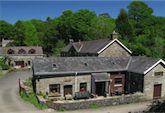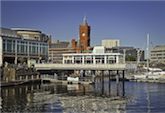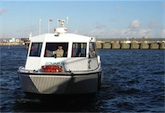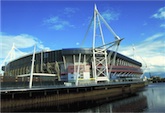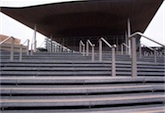If you go down to the Bay today you might see a giant golden armadillo! What used to be Tiger Bay and one of the world’s largest coal ports is now transformed into a modern shop and restaurant-fronted bayside development, complete with its own Opera House.
The Wales Millennium Centre, with its copper-tiled roof reflecting the sun is the centrepiece and architectural landmark of the new Cardiff Bay development. With probably the world’s largest poem etched into its face, and the slate walls man-made versions of the Glamorganshire Heritage coast, the building is representative of its home country – inspired by Wales and built by Welsh materials at a cost of £106m.
The curtain finally went up on the Millennium Centre Cardiff in 2004 with a gala opening. The main theatre, named after a South African businessman benefactor has a capacity of 1,900 and its deceptively huge stage could fit not only the stage of Cardiff’s smaller New Theatre, but also its auditorium! The Centre houses additional theatres and is home to the Welsh National Opera, Hijinx Theatre and Diversions Dance company, among others. There is even a 150-bed dormitory tucked away, run by Urdd Gobaith, the childrens Eisteddfod.
The architect had this to say: “Entering the building, the visitor steps out of the real world.” The classical tradition of carved inscriptions over entrances of important civic buildings continues in a contemporary manner with the poem. It was written by Wales’ National Poet, Gwyneth Lewis, and with each six-foot tall letter made of stained glass and set in glass-reinforced gypsum she said: “I find it quite shocking to see them so large.”
Each of the letters of the inscription is a window of its own, opening up the theatre foyers for people looking in, and looking out. And what is the bilingual poem? “In these stones horizons sing” is the English part. Not just a translation, the Welsh part says: “Creu Gwir fel Gwydr o Ffwrnais Awen” which means: ‘Creating truth like glass from inspiration’s furnace.’
Ms Lewis said: “I wrote the words to reflect the cultural ambition of the Centre. They draw both on Wales’s industrial past and the institution’s location in Cardiff Bay, once the greatest coal port in the world.”
She wanted the words to reflect the architecture, the copper dome reminding her of the furnaces of Wales’s industrial past and Ceridwen’s cauldron, from which the early poet Taliesin received his inspiration. ‘Awen’ suggests poetic inspiration and the general creative vision from which aspirations are formed. Ms Lewis thought of the stones inside the theatre singing with music wanted to convey the sense of an international space created by the art of music.
She continued: “The windows out of which the words are made suggest an ideal of poetry: clear enough to let light in and out, offering enough a distinctively local view of the world; it should speak a truth which is transparent, beautifully crafted but also fragile and, therefore, doubly precious.”
Inside the theatre are the usual cafes, bars and shops with a hands-on interactive gallery and on the upper levels a visual art exhibition. Guided tours are available, and free performances take place regularly, usually on a daily basis – check the Wales Millenium Centre website for more details of what’s on.
Getting to the Wales Millenium Centre (or Center) from Swansea Valley Holiday Cottage Accommodation
(i) By car. Our cottages are an easy 45 minute drive from the Wales Millenium Centre along the M4 motorway. Leave the M4 at junction 33 (Signed Cardiff (West), Barry, Penarth, Cardiff Airport & A4232). Join the A4232 and continue for about 9.3 miles. Leave the A4232 just before the Butetown Tunnel and follow the signs for Techniquest. Continue along Stuart Street and turn right at the first set of lights. The Wales Millennium Centre is in front of you. The postcode for you satnav is CF10 5AL.
